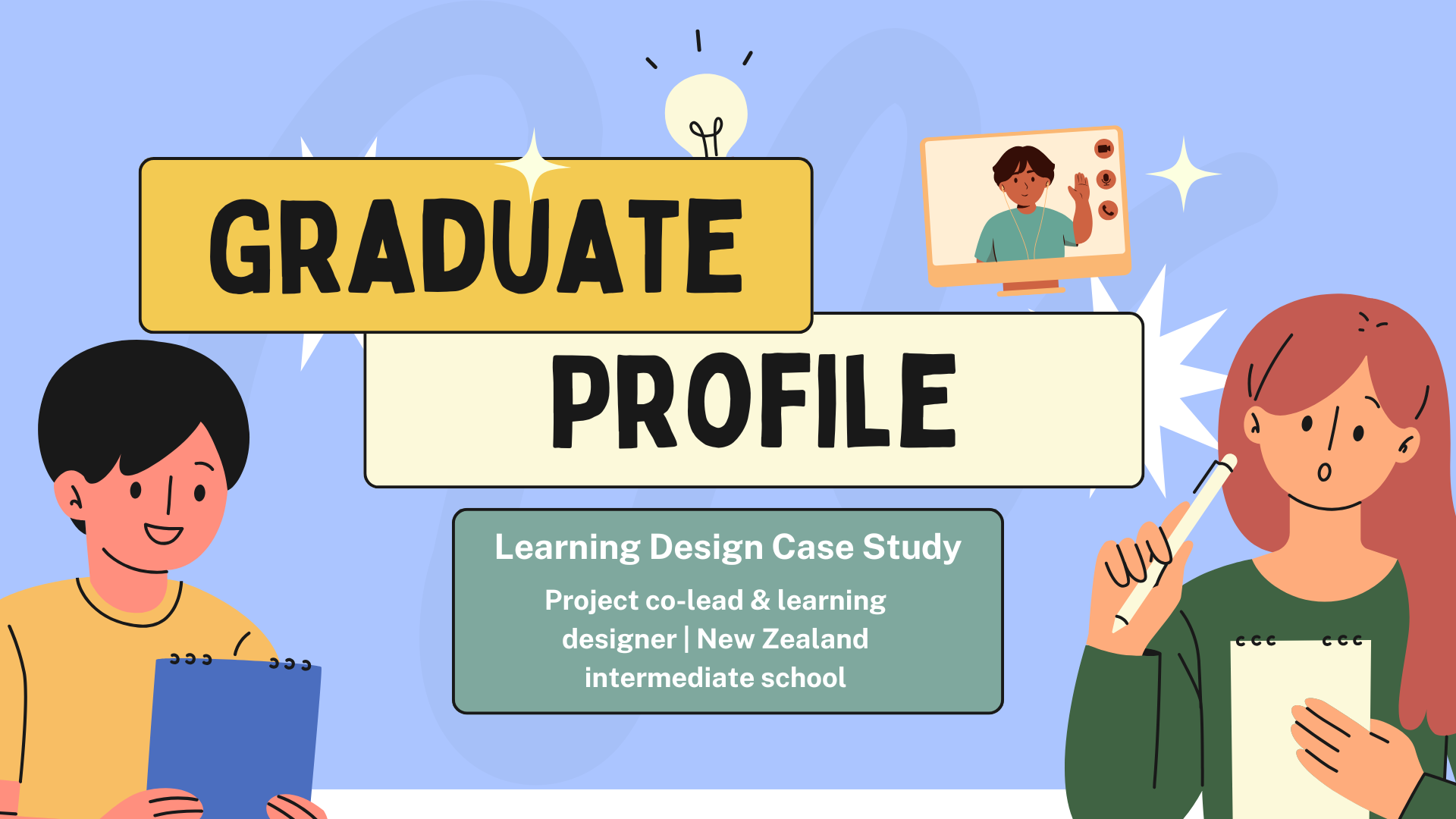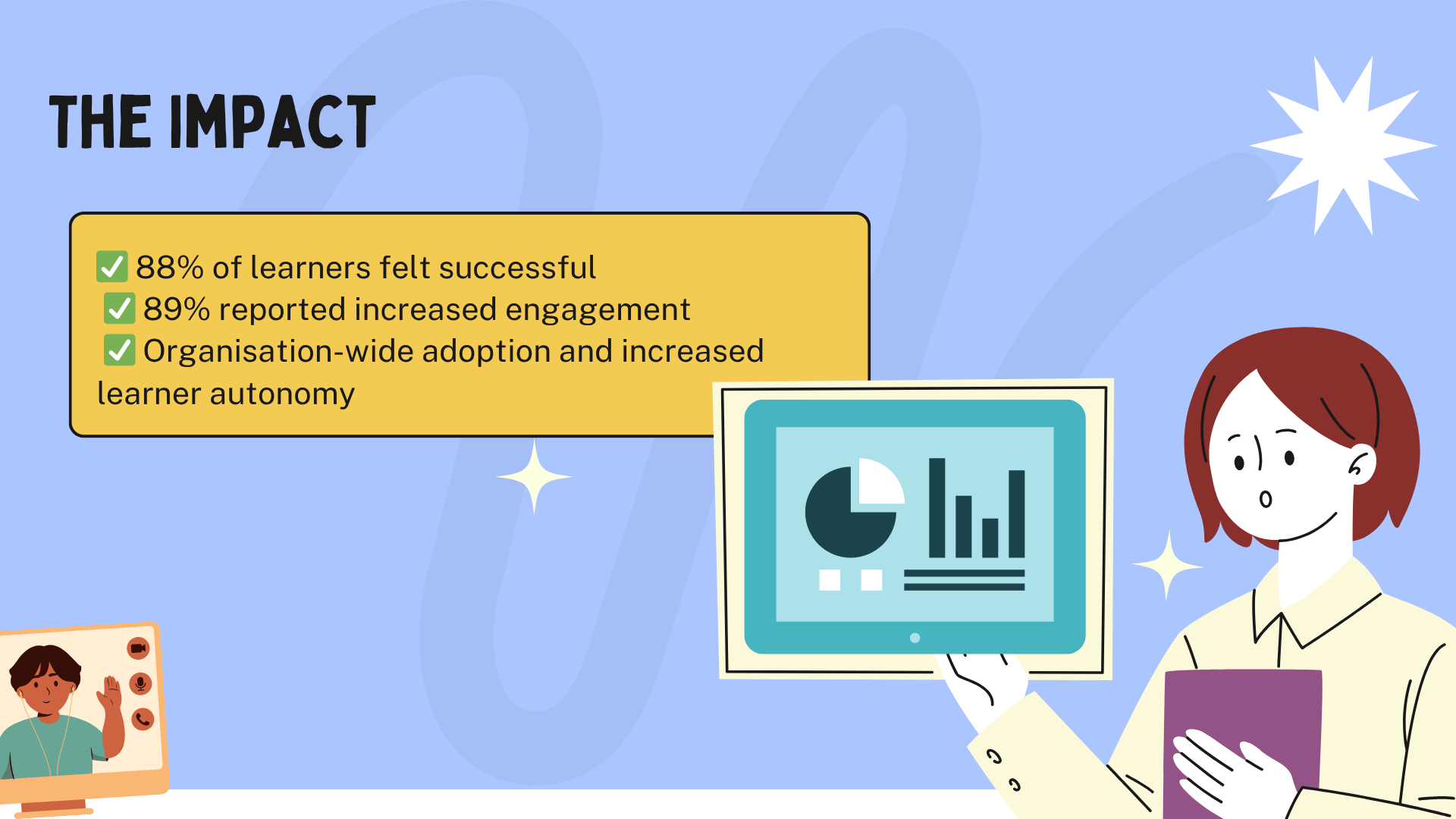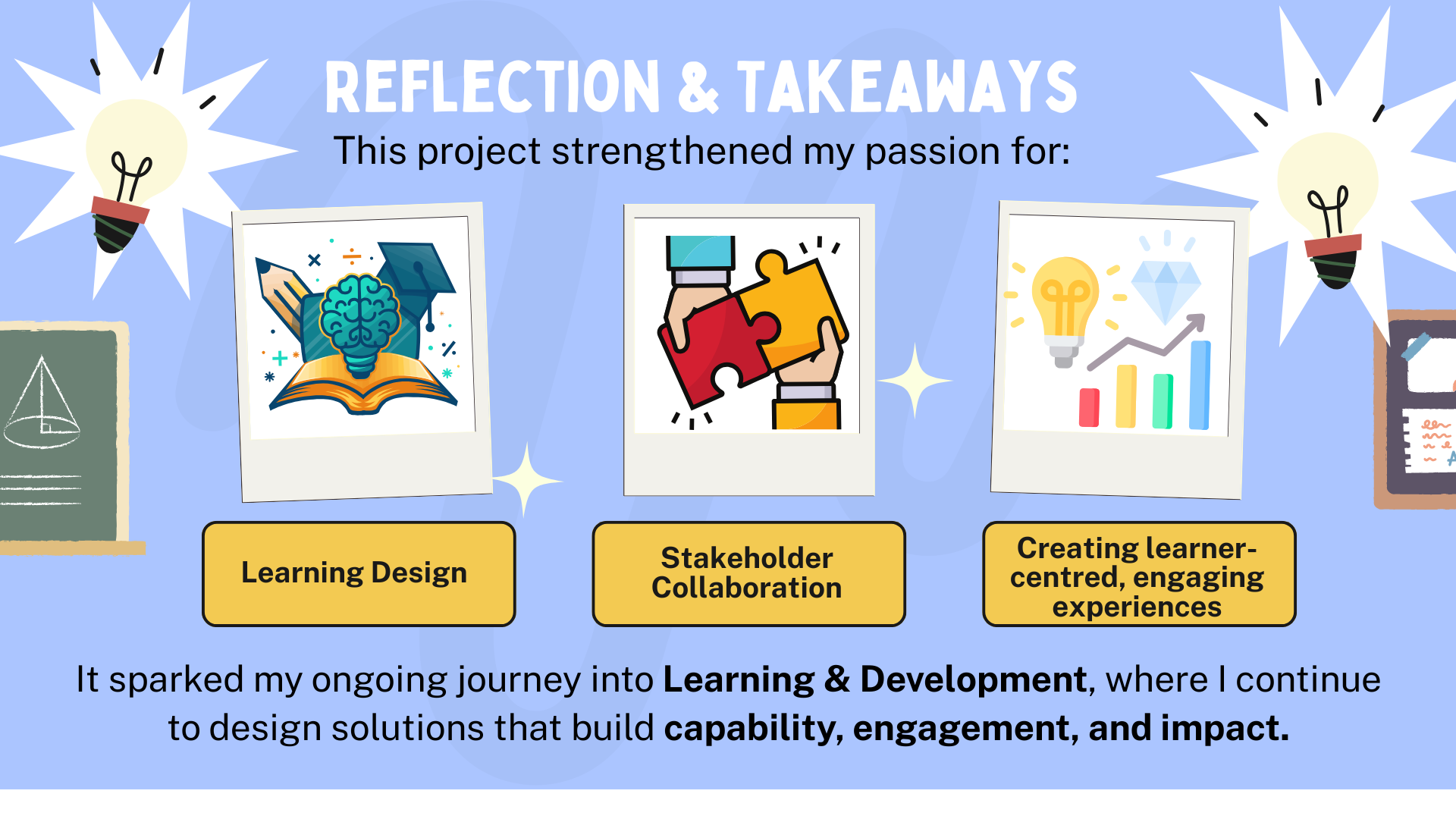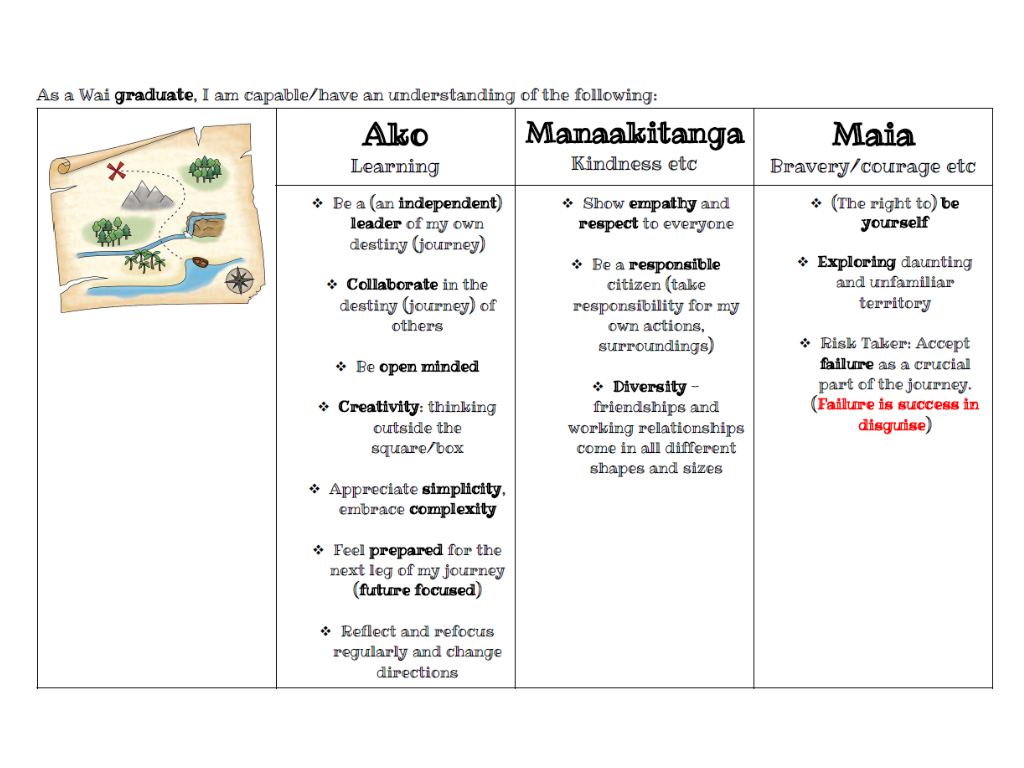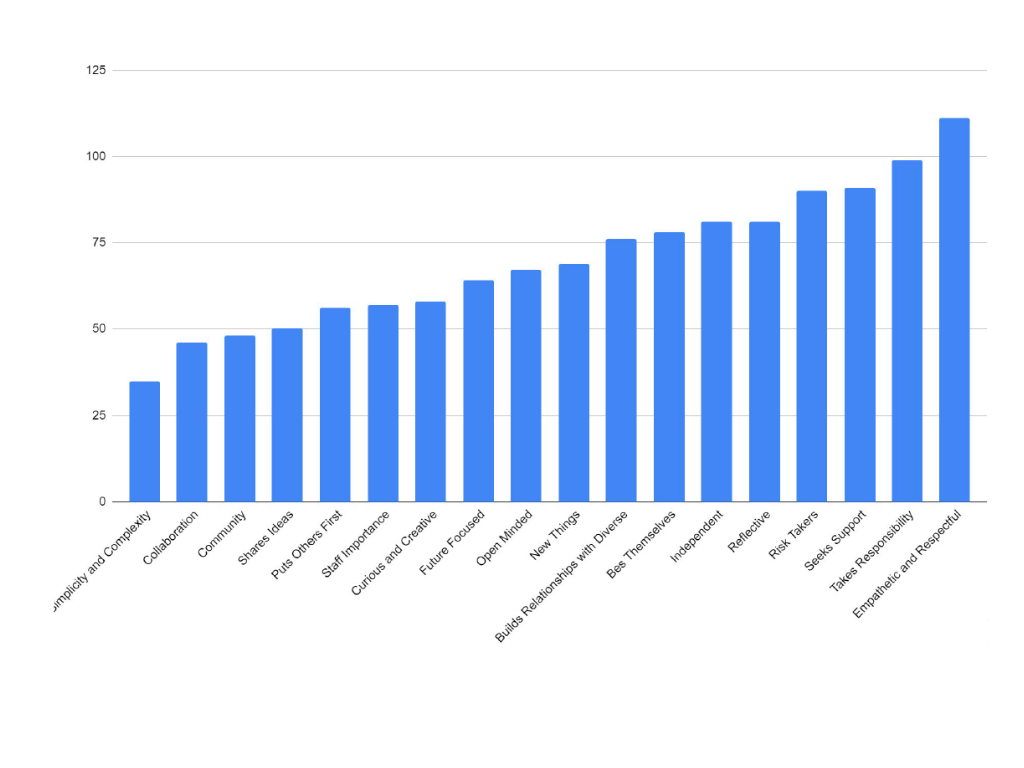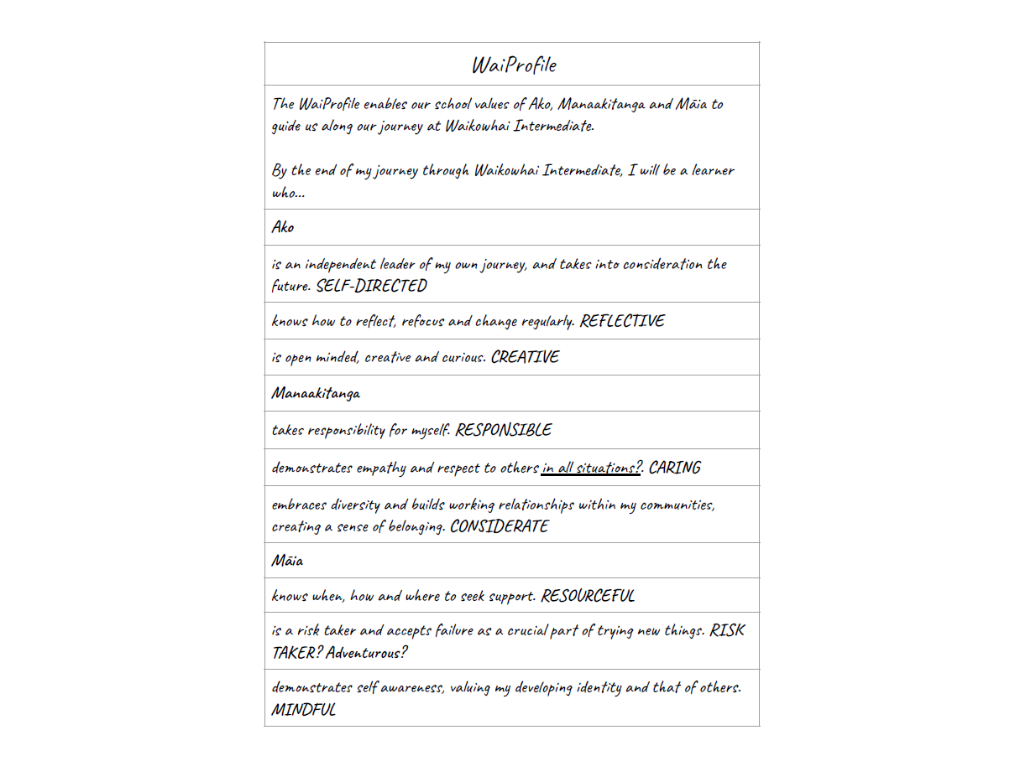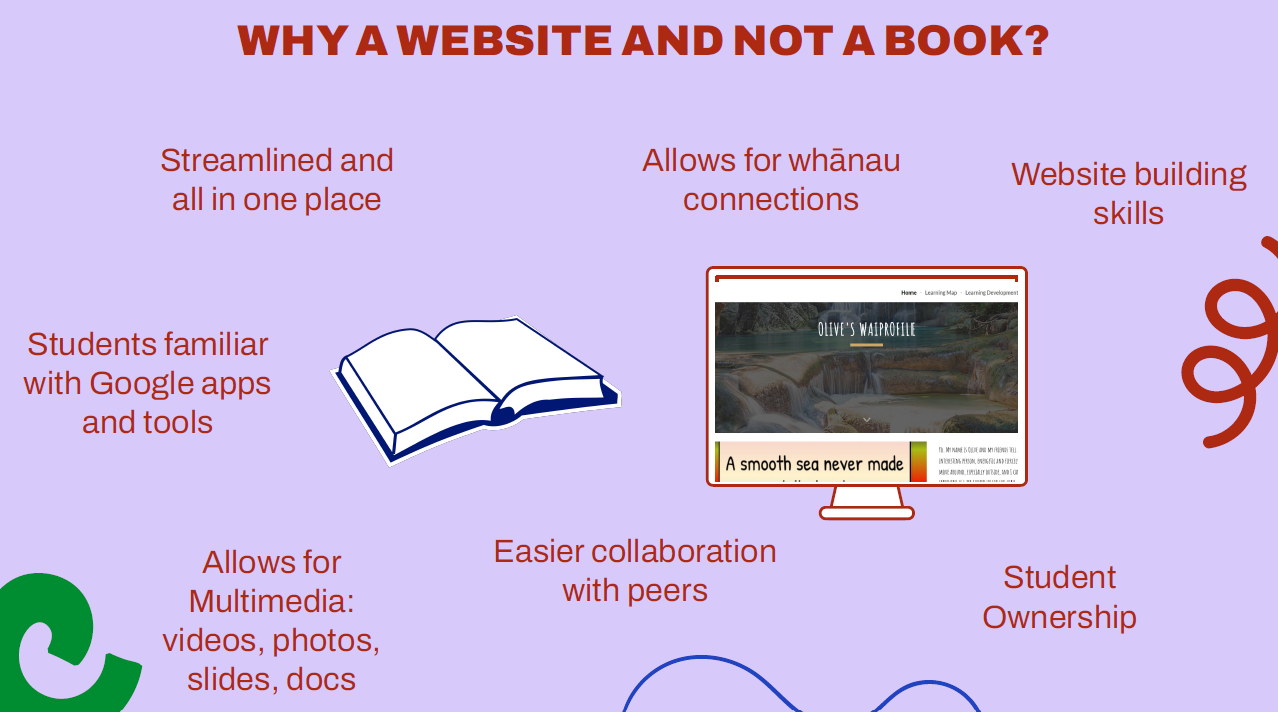During my time at an Auckland intermediate school, I co-led the design and implementation of a digital Graduate Profile. This was a large-scale problem-solving project that required analysing needs, designing and developing new systems, and facilitating adoption across staff, students, and families. The Graduate Profile replaced outdated paper-based processes with a digital and interactive tool that aligned the school’s culture, values, and learner outcomes.
It quickly became the backbone of the school: bringing values to life, giving learners greater agency and direction for their next stage, and building transferable skills beyond the classroom.
Graduate Profile
Target Learner
Students, teachers, and families at an Auckland intermediate school, all needing a clearer, more purposeful way to see and support progress.
Co-lead and Learning Designer, responsible for the full process from analysis through to evaluation.
My Role
Padlet (communication)
Google Docs and Sheets (collaboration)
Google Sites (design and develop)
Google Forms and sheets (analysis and evaluation)
Tools Used
Mid 2022 – Concept & Drafts: First prototypes and indicators shaped with community voice.
2023 – Rollout: Staff PD, schoolwide launch, Board & ERO updates.
Late 2023 – Refinement: Resource bank built, groundwork for 2024 set.
The project has continued to evolve beyond 2023.
Timeline
-
Before this project, the school had no Graduate Profile, even though most schools use one to define their purpose and direction. Instead, participants worked through a paper-based performance development process. In practice, it often became a tick-box exercise, with many finding it difficult to set goals that inspired or motivated them. The system was hard to manage, inconsistent across classes, and not engaging for families. Most importantly, it failed to connect with the school’s newly developed values, leaving a clear gap between what the organisation stood for and what participants actually experienced in practice.
The business goal was to close this gap by developing a Graduate Profile that embedded values into a consistent, motivating framework for all participants.
-
We co-designed a Graduate Profile that became the heart of the organisation. It drew inspiration from the old performance development process but transformed it into something broader and more purposeful. The Profile anchored the values in daily practice, provided a shared language for learners, staff, and families, and gave participants more ownership of their progress.
To give the Profile a chance to take off, we reshaped the timetable so learners had dedicated time to engage with it. We also redesigned the school’s badge recognition system, which had previously celebrated only sport, academia, and the arts. The new points-based system linked directly to the Graduate Profile values, giving all learners opportunities to be recognised for a wider range of skills and strengths.
My Process
We began by scanning what other organisations in the education sector were doing with their Graduate Profiles. The common thread was clear: they were values-led, built around indicators that described what each value looked like in action. That gave us the starting point we needed and formed the basis of our needs analysis.
What stood out most was that successful Profiles were coherent across the whole school, had genuine buy-in from participants, staff, and families, and kept things simple without losing depth. Just as importantly, they focused on growth rather than ranking performance.
We also aligned our early planning with the external evaluator’s (Education Review Office - ERO) evaluation model, sharing initial ideas in 2022, at the start of the project, and gaining early feedback on how this process could strengthen internal review.
Analysis
ERO feedback reinforced the project’s direction and highlighted the strength of our internal evaluation process.
I drafted the first set of indicators, linking them directly to our school values (Ako, Manaakitanga, and Māia). This gave the project traction and showed how a Graduate Profile could bring our values to life. From there, we worked these into a first draft that was ready to share more widely.
We treated leadership, governance, and family representatives as subject matter experts (SMEs), ensuring their voice shaped the indicators alongside learner input. From there, we extended consultation across the wider community. Learners, staff, and families were invited to vote on the indicators they felt best reflected the organisation’s culture and values. Clear patterns emerged, with qualities like empathy, responsibility, risk-taking, and reflection coming through most strongly. These results were collated and shared at staff meetings, giving us a data-driven foundation to refine the drafts.
Design
At the start of 2022, before the Graduate Profile project officially began, I had already started experimenting with digitising our old goal-setting system. As a teacher using it daily, I could see it wasn’t effective. Participants kept scrapbook-style journals that quickly became disorganised, paper-heavy, and uninspiring.
Because the school was already using Google Suite, I trialled a digital version in Google Sites. My students built their own learning sites from this prototype, and the benefits were immediate. It was more organised, required less printing, and made it easier to share evidence. At the time I was the only staff member using this approach, but it proved the concept could work.
Later that year, during the early stages of the Graduate Profile project, I presented this idea to leadership and the Graduate Profile team. From there, my early prototyping acted as rapid user testing, while staff and leadership served as SMEs, validating that the design aligned with both classroom needs and organisational priorities.
We trialled the idea with a small sample of classes. Participants enjoyed publishing their sites and found it more meaningful than paper journals. Staff valued how evidence could be added more easily and how the layout supported consistency and visibility. This feedback confirmed that a digital, evolving model was the right direction before developing it further to align with the new Graduate Profile framework.
Once the indicators were finalised, they became the foundation of the new system. Instead of setting vague goals, learners now worked on developing themselves against each indicator, linking progress directly to the school’s values. This gave the process more direction and made the values visible in everyday learning.
We also redesigned and integrated the school’s badge recognition system into the framework. Previously, badges only recognised achievement in sport, academics, or the arts. The new system was rebuilt so that each badge aligned with a school value, broadening recognition to include the full range of learner strengths. For many, it was the first time they saw their unique skills and contributions valued in a formal way.
Together, these design choices turned the Graduate Profile into more than a framework. It became a practical, interactive system that learners and staff could use daily: structured, values-led, and deeply embedded in the school’s culture. The design proved that learning can feel as good as it looks when it’s both functional and engaging.
Finalised Indicators
Develop
Our aim was to launch organisation-wide at the start of 2023. As one of the co-leads of the Graduate Profile team, I designed the site templates and led the start-of-year professional development to prepare teachers for implementation.
Each participant and facilitator was set up to build their own Graduate Profile sites using the updated templates. These included:
An embedded Google Sheet tracker to monitor progress against indicators
A Padlet space for reflection and goal setting
Layouts that made evidence easy to upload and share
I refined my original templates to align with the Graduate Profile, redesigning them to work directly with the indicators rather than the previous performance development system.
The aim was to ensure staff were confident in both the how and the why before rolling the framework out. I built and refined the templates, provided step-by-step guidance, and worked closely with colleagues to make sure the system was ready to launch school-wide.
Explore the mock-up Graduate Profile site template used during teacher training and the rollout below:
Implementation
Implementation began with staff using the job aids and slides we produced to build Graduate Profile sites with their classes. As a co-lead of the project, I facilitated this process in classrooms, modelling it with my own learners while other teachers observed.
One of the first challenges participants and staff faced was knowing what to do to actively work towards the indicators (referred to as Learning Developments). To address this, I invited teachers to observe my learners in action and worked with them to create a shared bank of examples as a starting point. Some of the language in the indicators also needed breaking down. For example, terms like self-regulated learner were unpacked with staff to make them more accessible.
A sample of Padlet reflections show how staff were processing these early challenges and identifying next steps.
To make the indicators more tangible for learners, I designed a case study character, ‘Fred.’ His profile gave clues about his strengths and challenges, and learners were tasked to use the indicators to suggest how he might build new strengths. This storytelling approach helped participants connect more personally with the Graduate Profile and gave teachers a practical way to model how abstract ideas could be applied in real contexts.
Alongside this, I initiated a starter bank of resources to inspire ideas for how indicators could be put into action. I then collaborated with a colleague to expand it further, drawing on real time examples. This gave learners practical entry points for their own development and supported staff with more confidence and consistency across classes.
In addition to classroom implementation, as a team we presented the Graduate Profile project to the governance group (Board of Trustees) early in 2023. Sharing the rationale, design decisions, and early progress helped secure buy-in at governance level and gave the Board a clear picture of how the Profile was beginning to impact practice. We framed this update around the business goal, showing how the Graduate Profile supported values-led growth and improved organisational consistency.
Midway through the rollout, we met with external evaluators (ERO) to share progress and agree on a formal evaluation plan. This ensured the project’s impact was being measured against organisational goals and that future development was guided by clear, data-driven evidence.
My key role focused on building the practical scaffolds (templates, job aids, and resources) while as a team we worked to embed the Profile through staff workshops, governance updates, and evaluation with ERO.
Rollout Resources and Examples
Evaluation
Evaluation was built into the Graduate Profile rollout from the start, using both learner and staff voice to track barriers, confidence, and engagement.
Key findings from 2023:
Confidence: By Term 4, 70% of learners felt confident they knew what to do during Graduate Profile time.
Success (in action): 44% of learners felt successful in Term 2, rising to 50% by Term 4.
Success (potential): Learners who believed they could succeed grew from 42% in Term 2 to 55% by the end of the year.
Autonomy: Learners reporting control and ownership of their learning grew from 54% to 64%. Only 40% felt the same autonomy in other curriculum areas, showing Graduate Profile created stronger conditions for learner agency.
Enjoyment: 47% of learners reported enjoying Graduate Profile sessions.
Staff voice:
Around 80% of class teachers fully embraced the Graduate Profile within their classrooms, each at their own pace.
The remaining 20% (specialist teachers) began considering how framework could connect to their subject areas, sparking the idea of enrichment opportunities in 2024.
Student Voice:
“Mostly time to work on our Grad Profile site (make it look prettier and add our
research posters on it), not much time to
work on our learning developments.”
“My Graduate Profile site says a lot about who I am and I have worked hard on it :D”
“It is more fun than other blocks including
P.E.”
Supports added during rollout:
A more comprehensive resource bank on the school website, giving participants independent entry points and teachers practical scaffolds.
Storytelling tools like the ‘Fred’ case study to make indicators relatable and actionable.
Next steps (planned for 2024):
Weekly Graduate Profile Day for enrichment, with learners opting into workshops and staff exercising their expertise.
Dedicated budget for participant led projects and resources.
Further refinements to the recognition system, ensuring progress was spread across both years and more closely aligned with the Graduate Profile values
Simplified wording of indicators to make them more user-friendly.
ERO recommendation to embed a coaching system to strengthen staff capability and buy-in.
Overall impact:
The evaluation confirmed that the original business goal was being met: joining the dots between what the organisation stood for and what learners experienced in practice. The Graduate Profile embedded the school’s values into a consistent and motivating framework, improving ownership and success. Feedback from staff and external evaluators highlighted areas to refine, but the Profile had already become the backbone of the school.
Success in Action during Term 2 and 4
1 = very low / 5 = very high
Success Potential during Term 2 and 4
1 = very low / 5 = very high
Autonomy during Term 2 and 4
1 = very low / 5 = very high
Project Reflection
A huge amount of work went into every stage of the process. The analysis ensured all stakeholders had an authentic voice. The design phase involved multiple prototypes, especially refining the wording of the indicators until the final set truly reflected the organisation’s culture and values. Iteration was key with each round of feedback helping shape something stronger and more meaningful.
Rolling out the Graduate Profile reminded me that no design is perfect at the start. Challenges surfaced quickly, but they became opportunities to adapt and showed how the right scaffolding can make change feel less daunting and more doable. The data speaks for itself: a 15% increase in learner belief in their own success over just 20 weeks is significant, especially for those firmly embedded in the old system. By the end of the first year, more than 60% felt they had autonomy during Graduate Profile time, showing that ownership and agency were becoming part of the culture.
Staff adoption was also strong, with 80% engaged. That included all class teachers and some specialist teachers, showing clear momentum. The next step was already mapped out through the 2024 enrichment programme, where every facilitator would contribute workshops based on their talents. This would expand learning opportunities and was expected to lift enjoyment levels beyond the 47% baseline.


